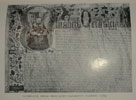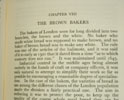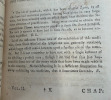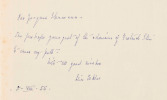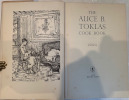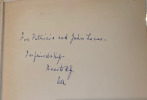A History of the Worshipful Company of Cooks, London.
Compiled by F. TAVERNER PHILLIPS, Citizen and Cook of London. Juxia medicinam esse coquorum officium simulantium et adulationem quartae particulae civilitatis. Quintilian’s translation of a quotation from Plato’s Gorgias. LONDON 1932 (the 450th anniversary of the Incorporation of the Cook’s company).
FIRST EDITION. 12mo. Inside front cover and fep with marbled paper. 1fep with inscription to C.Harold Ridge from the Compiler October 1946. Half title, Verso with notation of the book being a private printing for the Worshipful Company of Cooks. [1] Frontispiece of the Cooks’ Company Arms. Title page. [1] (1)viii Contents. 1p List of Illustrations. [1] (1) xii-xiii Preface. (1)xv Authors Forward. [1] (1)xviii-xi Introduction. [1] (1)2-191. [1] (1)104-207 Index. [1] 1fep. Inside back cover and fep with marbled paper. Original full red cloth binding with gilt text on spine and gilt armorial and text on front cover. Text block has original untrimmed pages. Considering its age, its in wonderful original condition.
- The Cook’s Guild of London is the oldest. This book was compiled and written by Taverner Phillips, who was also a cook. It was a private printing which probably means it was a very small number published. Including the frontispiece there are 13 Illustrations showing everything to do with the Cooks’ Company, its cups, badges and silverware, to a complete list past Masters and Wardens, and a very comprehensive history dating from its first mention in Deed Pole – May 21st 1500. The Roll of the Cooks’ Company however goes back to 1309-1312 when mention of Cooks’ redemptions have been extracted from the Letter Book D at the Guildhall, London. After the incorporation of the Cooks’ Company the earliest extant list to be found, is in a manuscript volume in the Public Record Office (Chapter House Books, Vol.93) under the heading of ‘Pastelers’. The title page of the volume is inscribed ‘The Companyes of all the Craftes or Mysteries of London’. Although undated, it was compiled in 1538. This is a fantasstic book. Also considering it was compiled and written by a cook it is all the more fascinating. It should be a part of the curriculum of all Catering colleges. An enlarged later edition was compiled and published in 1982. See item - ref:# 11112, on this site.





click on image to enlarge

Modern category
ref number:
11222 





